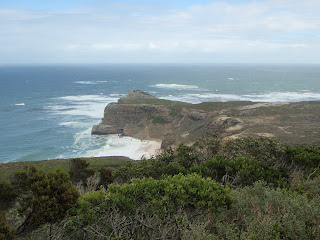Today we started off our day by attending church in the Township of Langa, which is the oldest informal settlement in Cape Town, developed in the 1920’s. The church service was conducted in a traditional Catholic setting but the preist addressed the congregation in Xhosa, which is the native language spoken throughout the township. Unlike Western Catholic Church services that the group has experienced, the Langa congregation integrated song and dance into their service. There were few instruments used and the congregation created a lively atmosphere. Our group felt very involved and included in the service. We noticed that the priest spoke both in English and Xhosa, adapting the service due to our presence. The group even had the opportunity to speak to some of the regular congregation members after the service. The church acts as a major community center where it provides many with adult education, pre-school, and grade school which is very important for improving the living conditions and ones socio-economic status. Besides being a great place to pray and worship, the church’s role in this community is vital.
At the end of our walk, we stopped at a community center. This center was the focus of the town. Here, we saw the craftwork that people in the community created. They taught us about their practice and skill. Then we browsed a small shop in the community center where all the handmade art was sold. Many of the students purchased the artwork; such as sand paintings, handcrafted pottery, jewelry, key chains, and wood carvings. The profits of our purchases will go directly back into the community center, which in turn will contribute to developing and improving the conditions of the township.
Once we finished our shopping spree at the community center, we were able to meet with a young man who is HIV positive. We were first introduced to him at the church, and then we had the opportunity to have a short interview with him about his life and the hardships faced in his community. The sixteen-year-old boy disclosed his personal experience living in Langa and with HIV. He gave us an emotional interview that touched our hearts and made us see how much help the people in Langa need.
We continued through the township by bus and saw how the people of Langa lived. We knew that the government had been doing a lot of work in the township, but the distinction between the impoverished houses and the new ones that were being created was too great. The problem with housing all the people is so large that even with years of progress the problem won’t be solved. At the end of our drive, we stopped to see the town’s traditional healer, otherwise known as a medicine man. The traditional healer talked to our group about his practices. He explained to some of the students that there is no word for HIV/AIDS in Xhosa. This presents a huge problem for the community because when people come to the healer with AIDS, he is not able to ask the ancestors for advice, like he normally would. This is a problem because now people are not receiving the treatment or information that they need to live with the virus. The traditional belief system of the community can’t handle this health epidemic.
The students felt that this was a tremendously heart-warming day. We felt like we learned a lot about the community and other groups of people in South Africa. The devastation that we saw in the community helped us to realize that we should not take our lives back in the United States for granted. We are excited to continue learning about Langa and other similar communities around Cape Town.
Pictured Below: A Home in Langa

Pictured Below: A small food shop in Langa

Pictured Below: Langa


Traditional Healer

Langa

The children of Langa


Langa's Community Center

Langa



Steve Townsend, Marist College's Student Body President talking with a Langa resident






















